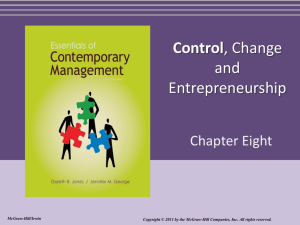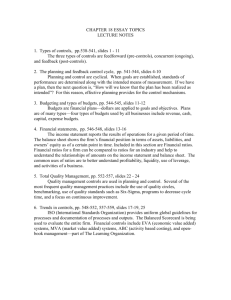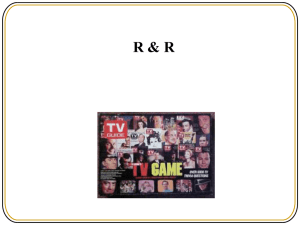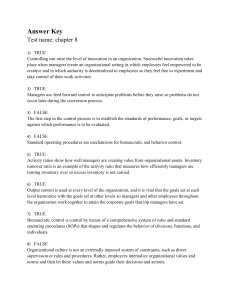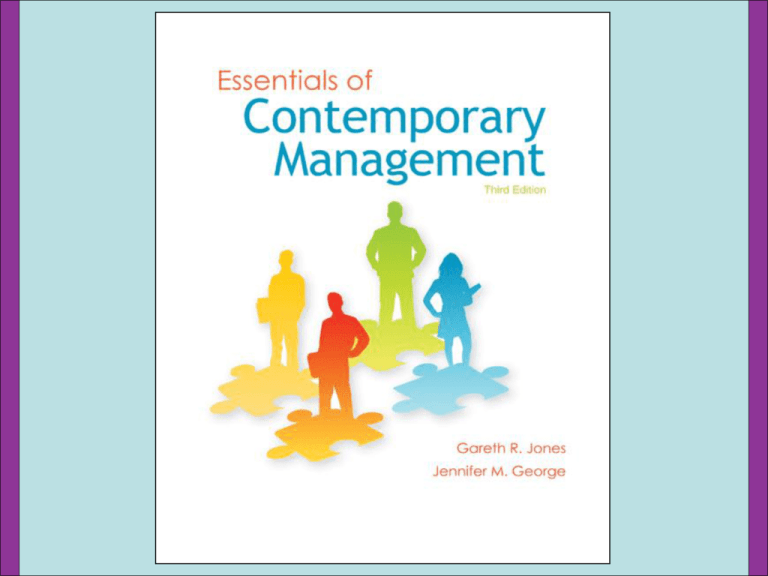
McGraw-Hill/Irwin
Copyright © 2009 by The McGraw-Hill Companies, Inc. All rights reserved.
Chapter 8
Control, Change and
Entrepreneurship
McGraw-Hill/Irwin
Copyright © 2009 by The McGraw-Hill Companies, Inc. All rights reserved.
Learning Objectives
1. Define organizational control, and
identify the main output and behavior
controls managers use to coordinate and
motivate employees
2. Explain the role of clan control or
organizational culture in creating an
effective organizational architecture
8-3
Learning Objectives
3. Discuss the relationship between
organizational control and change, and
explain why managing change is a vital
management task
4. Understand the role of entrepreneurship
in the control and change process
8-4
What is Organizational
Control?
• Controlling
–Process where managers monitor and
regulate how efficiently and effectively an
organization and its members are performing
the activities necessary to achieve
organizational goals
8-5
Organizational Control
• Managers monitor and regulate how
efficiently and effectively an organization
and its members are performing the
activities necessary to achieve
organizational goals
8-6
Organizational Control
• A control system contains the measures that
allow managers to assess how efficiently the
organization is producing goods and services
• Without a control system in place, managers
have no idea how well their organization is
performing and how its performance can be
improved
8-7
Control Systems and IT
• Control Systems
–Formal, target-setting, monitoring, evaluation
and feedback systems that provide managers
with information about how well the
organization’s strategy and structure are
working
8-8
Control Systems
A good control system should:
–be flexible so managers can respond as
needed
–provide accurate information about the
organization
–provide information in a timely manner
8-9
Three Types of Control
Figure 8.1
8-10
Question?
What type of control gives managers
information about customers’ reactions
to goods and services?
A. Feedforward Control
B. Concurrent Control
C. Feedback Control
D. Benchmark Control
8-11
Types of Control
• Feedforward Control
–Control that allows managers to anticipate
problems before they arise
• Concurrent Control
–Give managers immediate feedback on how
efficiently inputs are being transformed into
outputs so that managers can control
problems as they arise
8-12
Types of Control
• Feedback Control
–Control that gives managers information about
customers’ reactions to goods and services so
that corrective action can be taken if
necessary
8-13
Four Steps in Organizational
Control
Figure 8.2
8-14
The Control Process
1. Establish standards, goals, or targets
against which performance is to be
evaluated
–
Standards must be consistent with the
organization’s strategy
8-15
The Control Process
2. Measure actual performance
– Managers can measure outputs resulting
from worker behavior or they can measure
the behavior themselves.
8-16
The Control Process
3. Compare actual performance against
chosen standards
– Managers must decide if performance
actually deviates, often, several problems
combine creating low performance
8-17
The Control Process
4. Evaluate the result and initiate
corrective action if the situation is not
being achieved
– Standards have been set too high or too
low.
– Workers may need additional training or
equipment.
•
This step is often hard since the environment is
constantly changing.
8-18
Three Organizational Control
Systems
Figure 8.3
8-19
Discussion Question
What is an example of financial control?
How are financial controls used?
A. Activity drivers
B. Revenue ratios
C. Liquidity ratios
D. Net income budget
8-20
Financial Measures of
Performance
• Profit ratios
–Measures of how efficiently
managers convert resources
into profits.
–return on investment (ROI).
• Liquidity ratios
–Measures of how well managers protect
resources to meet short term debt—current
and quick ratios.
8-21
Financial Measures of
Performance
• Leverage ratios
–Measures of how much debt is used to
finance operations—debt-to-asset and timescovered ratios.
• Activity ratios
–Measures of how efficiently managers are
creating value from assets—inventory
turnover, days sales outstanding ratios.
8-22
Organizational Goals
• Organizational Goals
–Each division within the firm is given specific
goals that must be met in order to attain
overall organizational goals.
8-23
Organizational Goals
• Goals should be specific and difficult, but
not impossible, to achieve (stretch goals).
• Goal setting and establishing output
controls are management skills that are
developed over time.
8-24
Organization-Wide Goal Setting
Figure 8.4
8-25
Operating Budgets
• Operating Budget
–A blueprint that states how managers
intend to allocate and use the
resources they control to attain organizational
goals effectively and efficiently
• Each division is evaluated on its own budgets for
cost, revenue or profit
8-26
Operating Budgets
Three components are the essence of
effective output control
• Objective financial measures
• Challenging goals and performance
standards
• Appropriate operating budgets
8-27
Problems with Output Control
Managers must create output standards
that motivate at all levels.
–Standards should not cause managers to
behave in inappropriate ways to achieve
organizational goals.
8-28
Direct Supervision
Managers who:
• Actively monitor and observe the behavior
of their subordinates
• Teach subordinates the behaviors that are
appropriate and inappropriate
• Intervene to take corrective action as
needed
8-29
Management by Objectives
• Management by Objectives (MBO)
–A goal-setting process in which managers and
subordinates negotiate specific goals and
objectives for the subordinate to achieve and
then periodically evaluate their attainment of
those goals
8-30
Management by Objectives
1. Specific goals and objectives are established
at each level of the organization
2. Managers and their subordinates together
determine the subordinates’ goals
3. Managers and their subordinates periodically
review the subordinates’ progress toward
meeting goals
8-31
Bureaucratic Control
• Bureaucratic Control
–Control through a system of rules and
standard operating procedures (SOPs) that
shapes the behavior of divisions, functions,
and individuals.
8-32
Bureaucratic Control
Problems with Bureaucratic Control
• Rules easier to make than discarding
them, leading to bureaucratic “red tape”
and slowing organizational reaction times
to problems
• Firms become too standardized and lose
flexibility to learn, to create new ideas, and
solve to new problems
8-33
Organizational Culture
• Organizational Culture
–The shared set of beliefs, expectations,
values, norms, and work routines that
influences how members of an organization
relate to one another and work together to
achieve organizational goals
8-34
Organizational Culture
• Clan Control
–Control exerted on individuals and groups in
an organization by shared values, norms,
standards of behavior, and expectations
8-35
Adaptive Culture
• Adaptive Culture
–Culture whose values and norms help an
organization to build momentum and to grow
and change as needed to achieve its goals
and be effective
8-36
Inert Culture
• Inert Culture
–Culture that leads to values and norms that
fail to motivate or inspire employees
–Leads to stagnation and often failure over
time
8-37
Organizational Control and Change
Figure 8.5
8-38
Organization Change
• Organization Change
–Movement of an organization away from its
present state and toward some desired future
state to increase its efficiency and
effectiveness
8-39
Steps in the Organizational
Change Process
Figure 8.6
8-40
Organization Change
• Organizational Learning
–Process through which managers try to
increase organizational members’ abilities to
understand and appropriately respond to
changing conditions
–Impetus for change
–Can help members make decisions about
changes
8-41
Organization Change
• Top-down change
–Top managers identify what needs to be
changed, decide what to do, and then move
quickly to implement changes throughout the
organization
8-42
Organization Change
• Bottom-up change
–Managers at all levels work together to
develop a detailed plan for change
8-43
Question?
What is the process of comparing one
company’s performance on specific
dimensions with the performance of
other high performance organizations?
A. Financial comparison
B. Objective benching
C. Benchmarking
D. Competitor analysis
8-44
Organization Change
• Benchmarking
–Process of comparing one company’s
performance on specific dimensions with the
performance of other high performance
organizations
8-45
Entrepreneurship, Control, and
Change
• Entrepreneurs
–People who notice opportunities and take
responsibility for mobilizing the resources
necessary to produce new and improved
goods and services
8-46
Entrepreneurship, Control, and
Change
• Intrapreneurs
–employees of existing organizations who
notice opportunities for product or service
improvements and are responsible for
managing the development process
8-47
Entrepreneurship, Control,
and Change
• Entrepreneurship
–Mobilization of resources to take advantage of
an opportunity to provide customers with new
and improved goods and services
8-48
Entrepreneurship, Control,
and Change
Entrepreneur Success
• An entrepreneur must hire managers who
can create an operating and control
system that will let a new venture survive
and prosper
8-49
Video Case: Johnson & Johnson
• Why is eUniversity a valuable learning tool
for the Johnson & Johnson organization?
• What are the benefits, both expected and
unexpected, of eUniversity?
8-50
Movie Example: Gung Ho
How do the employees
of Assan Motors react
to changes from the
new Japanese
management?
8-51

